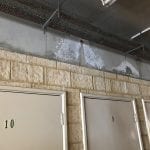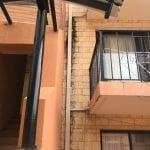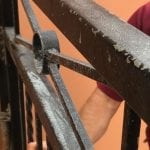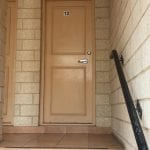If you are living in a Strata Complex that has these components, a Strata Inspection will identify areas that require fixing prior to a wet winter.
(click to view video of inspector checking moisture levels)
Ian conducted this strata inspection today in East Perth. This is the first of three strata inspections on this property that will identify structural and non-structural issues effecting it’s appearance and intended purpose. It is only the initial inspection as he will be inspecting the internals and balconies of apartments to diagnose the problems and give recommendations on how to fix it.
It is clear that there has been some problems with this property for some time. Evident by the extent of the staining and the knock on effects on adjoining structures.
- Efflorescence: It glistens, it’s white, and sometimes has a grayish tint. It flakes off the surface and is present only on the surface. It’s called “efflorescence,” and it’s a crystalline deposit of salts often seen on the surface of concrete, brick, stucco or natural stone surfaces. It occurs when water leaves behind salt deposits and is present on or in the masonry surface. This Strata property has it’s fair share of efflorescence however further investigation might suggest that only two balconies are the cause of most of it and the repair could be less than what you might initially think. The word efflorescence means “to flower out” in French. In this case, it is salt flowering out of surfaces. Efflorescence is found on the surface, but sub-efflorescence, known as spalling can be more expensive to fix.
Where is efflorescence found?
You can easily recognize efflorescence on walls, floors, retaining walls and other surfaces made of brick, stone, concrete or stucco. It’s often a white, powdery substance when seen on unsealed surfaces. If a floor or other concrete surface has been sealed, you may see a white blush under the sealer.
What is the composition of Efflorescence?
Efflorescence is composed of a variety of water-soluble salts. Different surfaces and different areas of the country are more likely to have particular combinations, which lead to a variety of colors.
How Does Efflorescence Happen?
For efflorescence to happen, you need water and salt. The salt comes from a range of sources. First, it may already be present inside the brick, stone or concrete. Or, the source may be the grout or Portland cement holding surfaces together. If the surface, such as a retaining wall, is in contact with soil, efflorescence could form. Finally, it could be present in the water itself in areas with hard water.
The salt must be dissolved in water and transported to the surface of the masonry, stone or concrete. The water may already be present in the surface itself. It could also come in from outside of the surface, dissolve salts and then evaporate, which leaves behind the efflorescence.
How Can You Control or Remove Efflorescence?
There are several construction techniques that can minimize the growth of efflorescence, such as controlling the amount of water used in mortar and grout. This said, the design and construction of the building will probably have the greatest impact. The building might have the best design but has not been built to specifications and therefore water is ponding instead of running away. Similarly, the building could have been constructed with absolute perfection however the drawings are a few millimeters off causing excessive water to fall on elements not intended for such conditions and deterioration of compounds occurs leaving water to slowly penetrate.
The best way to remove efflorescence depends on the surface and the composition of the salts. One method is to use a dry brush. For some salts, you can simply wash them away with a hand brush, mild detergent and a water rinse. Power washing is another option, depending on the surface. You may want to consult with a contractor to see if there is a recommended chemical cleaning agent for your surface and get instructions on how to use it safely. For example, a weak solution of muriatic acid might be safe for some surfaces, but it could damage others.
In general, cleaning efflorescence from a surface is an ongoing solution — much like a treatment — rather than a cure. Sealing a surface might be a solution, but if water still finds its way into the surface you could end up with spalling, which is a destructive process that should be avoided.
2. Non-slip features
Evident in the photos, the non-slip surface added to the lip of the stairs is peeling and has lost it’s effectiveness. While a very simple and cost effective item to fix, this can save a serious fall in properties such as this. The stairs are exposed to the elements and with insufficient water drainage they could end up a fall hazard and danger to occupants in heavy rain.
3. Ensure gutters and down pipes are not rusting, leaking or blocked prior to winter.
Another simple and straight forward inspection procedure however so often over looked. An important part of our strata inspection is to identify items that require cosmetic attention in order to maintain the building’s aesthetics and integrity. When living in high rise apartments often it is not the cost of labour, it is the cost of reaching the high places. For example, if a cherry picker is required and there is insufficient space to access the property, alternatives such as scaffolding could be required and the cost can increase dramatically in cases like this.
4. Bowing doors and door frames:
Older properties or poorly designed properties where water ingress has become a problem, doors and door frames can lose their integrity. They can become bowed an unappealing to look at. Where moisture is present and doors have expanded or frames have twisted, cold air can enter the unit and the door may not serve it’s intended purpose.
5. Peeling, flaking, unsealed or deteriorated external surfaces:
On this particular strata inspection, the eaves require sanding, sealing and repainting. The hand rails are in fair condition but will require sanding and repainting also. For other properties it might be the fences, fascias, letter boxes etc.
An obvious item not mentioned here is the roof coverings. Ensure tiled roof tops aren’t cracked and that any additions such as air conditioning units or skylights are sealed. Valleys and flashings should be fixed correctly and gutters kept clear of leaves and debris.
Strata sinking funds allow you and your council of owners to budget for such maintenance. BCI provide detailed strata inspection reports identifying the issue, the location, how to fix it, who should fix it, when it should be fixed and an estimate of how much it will cost. These reports mean that you will have funds reserved and ready to apply to any problems that might crop up without having to find the money every time.












